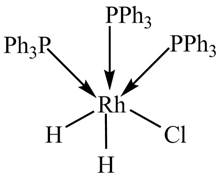
Concept explainers
(a)
Interpretation:
The
Concept introduction:
The number of unshared valence electrons on the metal is the number
Answer to Problem 18.9P
The
Explanation of Solution
The formula for calculation of
The formula for the calculation of oxidation state is given below
• n is the number of ligands.
•
•
•
Therefore, the oxidation state of
Now, valence electronic configuration of
L-type ligands have no effect on the
Value of
Therefore, the given complex is a
The value of
(b)
Interpretation:
The
Concept introduction:
The number of unshared valence electrons on the metal is the number
Answer to Problem 18.9P
The
Explanation of Solution
The formula for calculation of
The oxidation state of the metal is calculated by the formula given below.
Since phosphine is a neutral ligand and there is no overall charge on the complex.
The formula for the calculation of oxidation state is given below
• n is the number of ligands
•
•
•
So, the oxidation state of Pd in the complex is calculated as shown below.
Now, valence electronic configuration of
Value of
Therefore, the given complex is a
The value of
(c)
Interpretation:
The
Concept introduction:
The number of unshared valence electrons on the metal is the number
Answer to Problem 18.9P
The
Explanation of Solution
The given complex is shown below.

Figure 1
The formula for calculation of
The oxidation state of metal is calculated by the formula given below.
Since, phosphine is a neutral ligand.and there is no overall charge on the complex. The charge assosciated with chlorine and hydride ligands is
The formula for the calculation of oxidation state is given below.
• n is the number of ligands.
•
•
•
So, the oxidation state of Rh in the complex is calculated below.
The valence electronic configuration of Rh is
Value of
Therefore, the given complex is a
The value of
Want to see more full solutions like this?
Chapter 18 Solutions
Organic Chemistry Study Guide and Solutions
- please provide the structure for this problem, thank youarrow_forwardpresented by Morallen Lig Intermine the hand product for the given mution by adding atoms, bonds, nonhonding diarion panda скуль Step 3: Comp the draw the product Step 2: Agama workup Compithe 429 ملولةarrow_forwardReaction A 0,0arrow_forward
- presented by Morillon Leaning Predict the organic product for the min кусур HSC Adithane carved arnown to come than that to the condon slchroruis in acid in in aquishri with ноюarrow_forward6.15PM Sun Mar 30 K Draw the major product of this reaction. Include any relevant stereochemistry. Ignore inorganic byproducts. Problem 1 of O H [PhзPCH2CH3]*C|¯ NaH Drawing > Q Atoms, Bonds and Draw or tap a nearrow_forward8:17 PM Sun Mar 30 Draw the major product of this reaction. Ignore inorganic byproducts. HSCH2CH2CH2SH, BF3 Probler Drawing Ato Bonds Clarrow_forward
- Name the major organic product of the following action of 4-chloro-4-methyl-1-pentanol in neutral pollution 10+ Now the product. The product has a molecular formula f b. In a singly hain, the starting, material again converts into a secule with the molecular kormula CIO. but with comply Draw the major organic structure inhalationarrow_forwardMacmillan Learning Alcohols can be oxidized by chromic acid derivatives. One such reagent is pyridinium chlorochromate, (C,H,NH*)(CICTO3), commonly known as PCC. Draw the proposed (neutral) intermediate and the organic product in the oxidation of 1-butanol by PCC when carried out in an anhydrous solvent such as CH₂C₁₂. PCC Intermediate OH CH2Cl2 Draw the intermediate. Select Draw Templates More с H Cr о Product Draw the product. Erase Select Draw Templates More H о Erasearrow_forwardIf I have 1-bromopropene, to obtain compound A, I have to add NaOH and another compound. Indicate which compound that would be. A C6H5 CH3arrow_forward
 Chemistry: Principles and ReactionsChemistryISBN:9781305079373Author:William L. Masterton, Cecile N. HurleyPublisher:Cengage Learning
Chemistry: Principles and ReactionsChemistryISBN:9781305079373Author:William L. Masterton, Cecile N. HurleyPublisher:Cengage Learning ChemistryChemistryISBN:9781305957404Author:Steven S. Zumdahl, Susan A. Zumdahl, Donald J. DeCostePublisher:Cengage Learning
ChemistryChemistryISBN:9781305957404Author:Steven S. Zumdahl, Susan A. Zumdahl, Donald J. DeCostePublisher:Cengage Learning Chemistry: An Atoms First ApproachChemistryISBN:9781305079243Author:Steven S. Zumdahl, Susan A. ZumdahlPublisher:Cengage Learning
Chemistry: An Atoms First ApproachChemistryISBN:9781305079243Author:Steven S. Zumdahl, Susan A. ZumdahlPublisher:Cengage Learning
 Chemistry: The Molecular ScienceChemistryISBN:9781285199047Author:John W. Moore, Conrad L. StanitskiPublisher:Cengage Learning
Chemistry: The Molecular ScienceChemistryISBN:9781285199047Author:John W. Moore, Conrad L. StanitskiPublisher:Cengage Learning General Chemistry - Standalone book (MindTap Cour...ChemistryISBN:9781305580343Author:Steven D. Gammon, Ebbing, Darrell Ebbing, Steven D., Darrell; Gammon, Darrell Ebbing; Steven D. Gammon, Darrell D.; Gammon, Ebbing; Steven D. Gammon; DarrellPublisher:Cengage Learning
General Chemistry - Standalone book (MindTap Cour...ChemistryISBN:9781305580343Author:Steven D. Gammon, Ebbing, Darrell Ebbing, Steven D., Darrell; Gammon, Darrell Ebbing; Steven D. Gammon, Darrell D.; Gammon, Ebbing; Steven D. Gammon; DarrellPublisher:Cengage Learning





